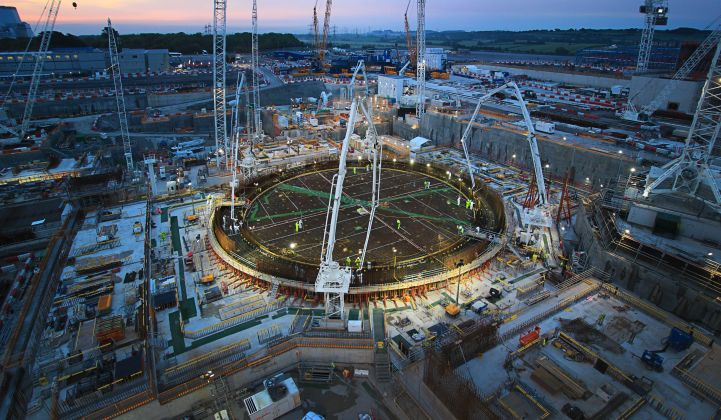French energy giant EDF has suffered another blow in the development of its controversial Hinkley Point C nuclear power plant in the U.K. after costs soared by as much as £2.9 billion ($3.6 billion), potentially rising to a total of more than £22 billion.
EDF said “challenging ground conditions” have made earthworks at the site more expensive than expected. A set of remedies are now underway with contractors, and depending on their success, costs will rise by between £1.9 billion to £2.9 billion. That means another 0.3 percent being stripped from the internal rate of return (IRR).
The two reactors under construction, which will total 3.2 gigawatts of generating capacity, are delayed nine and 15 months, respectively. First power is now expected in 2025.
Hinkley Point C has a 35-year contract for difference (CFD) with the U.K. government guaranteeing it £92.50 per megawatt-hour ($115). A review of that 2012 deal by the national spending watchdog called it “high-cost and risky.”
Last week’s CFD auction for renewable generation saw offshore wind prices drop to £39.65 per megawatt-hour.
The structure of the CFD means consumers aren’t exposed to increased costs beyond the strike price.
Jonathan Cobb, senior communication manager at the World Nuclear Association, pointed out that at the time of Hinkley CFD award in 2012, the price was comparable with those being awarded to other technologies, including offshore wind.
“Progress with offshore wind is welcome, but it is an intermittent supply," Cobb said. "Relying on gas to fill the gaps will not be possible if the U.K. is to achieve full decarbonization of its electricity generation mix."
"To provide supplies of electricity that are both clean and reliable the UK will need a broader range of low-carbon generation technologies, including a substantial contribution from nuclear,” Cobb said.
Unhappy returns
A series of delays at Hinkey Point C have seen EDF’s internal rate of return slide away, a familiar story for a number of nuclear projects attempted or planned in Europe and the U.S. in recent years.
In 2015, a budget forecast handed over to EU officials put the IRR at 11.4 percent. That has fallen steadily, and today's announcement puts the IRR at 7.6 to 7.8 percent.
In January, Hitachi hit the pause button on its own new-build nuclear plans in the U.K., citing financing issues. In November 2018, Toshiba scrapped its own plans to develop new nuclear capacity in the U.K. after failing to attract new partners to take a share in the venture.
The lone nuclear plant being built in the U.S., Georgia Power's Vogtle, is years behind schedule and billions of dollars over budget.
Despite the surface-level gulf in CFD prices between Hinkley Point C and renewables, the U.K. government has stuck by its plans to pave the way for new nuclear capacity. Since reaffirming that position in 2017, the government has set a net-zero-carbon climate target for 2050, with big implications for the electrification of the economy.
While the government wants to decarbonize as quickly and as economically as possible, its partial moratorium on onshore wind, lack of support for utility-scale solar and apparent blind spot when it comes to the potential of energy storage have undermined its efforts.
Seven of the U.K.'s eight existing nuclear power stations are set to go offline in the next 10 years. EDF hopes to follow up the Hinkley Point C development with another new site. If that follow-on project, Sizewell C, is ultimately built, Hinkley's strike price would drop to £89.50 per megawatt-hour, a sort of bulk-buy deal for the taxpayer.
EDF says Sizewell C would benefit from being a “near replica” of Hinkley C.
The U.K. government has opened a consultation to explore alternative ways to fund new nuclear. The proposal under investigation guarantees a return for the developer and raises revenue through bills.
That shifts the development risks to consumers, but, as all the finance doesn’t need to be in place from day one, it should theoretically draw in a larger pool of potential investors.
***
Wood Mackenzie is hosting an invite-only analyst briefing on the U.S. offshore wind sector in Boston the morning of Wednesday, October 23. Email [email protected] to express interest in attending.




